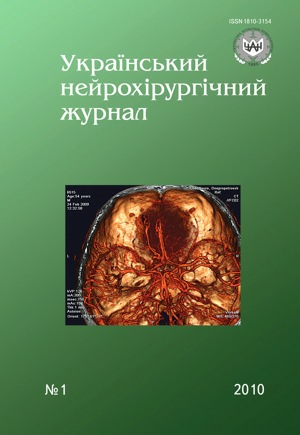Pathomorphological characteristics of cerebellum hemisphere dosed traumatic injury model in the experiment
DOI:
https://doi.org/10.25305/unj.88760Keywords:
травма задньої черепної ямки, експериментальна модель травми мозочка, морфологічні дослідженняAbstract
The improved method of rat’s cerebellum traumatic injury by means of direct mechanical stroke through undamaged hard cerebral membrane (cover) above external surface of cerebellum left hemisphere with registration of injuring factor’s strength is described in details. Morphological peculiarities of traumatic process of different heaviness in cerebellum tissue are researched. Taking into consideration data of morphological control optimal indices of stroke strength have been chosen to achieve a stable neurological deficit and injury focus forming in the cerebellum left hemisphere at high homogeneity among animals in experimental group.References
Крылов В.В. Повреждения структур задней черепной ямки / В.В. Крылов, А.Е. Талыпов // Неврол. журн. — 2002. — №6. — С.4–9.
Structural and functional alterations of cerebellum following fluid percussion injury in rats / J. Ai, E. Liu, E. Park, A.J. Baker // Exp. Brain Res. — 2007. — V.177, N1. — P.95–112.
Chase T. Induction of heat shock proteins and motor function deficits after focal cerebellar injury / T. Chase // Neuroscience. — 2001. — V.102, N3. — Р.603–614.
Effects of midline and lateral cerebellar lesions on motor coordination and spatial orientation / C.C. Joyal, C. Meyer, G. Jacquart [et al.] // Brain Res. — 1996. — V.739. — P.1–11.
Lalonde R. The effects of cerebellar damage on maze learning in animals / R. Lalonde, C. Strazielle // The Cerebellum. — 2003. — V.2, N4. — P.300–309.
Expression of netrin-1, slit-1 and slit-3 but not of slit-2 after cerebellar and spinal cord lesions / R. Wehrle, E. Camand, A. Chedotal [ et al.] // Eur. J. Neurosci. — 2005. — V.22. — P.2134–2144.
Characterization of a new rat model of penetrating ballistic brain injury / A.J. Williams, J.A. Hartings, X.-C. May Lu [et al.] // J. Neurotrauma. — 2005. — V.22, N2. — P.313–331.
Williams A.J. Severity level and injury track determine outcome following a penetrating ballistic-like brain injury in the rat / A.J. Williams, G.F.S. Ling, F.C. Tortella // Neurosci. Lett. — 2006. — V.408. — P.183–188.
Белошицкий В.В. Принципы моделирования черепно-мозговой травмы в эксперименте / В.В. Белошицкий // Укр. нейрохірург. журн. — 2008. — №4. — С.9–15.
Ноздрачев А.Д. Анатомия крысы (Лабораторные животные) / А.Д. Ноздрачев, Е.Л. Поляков: под ред. акад. А.Д. Ноздрачева. — СПб.: Лань, 2001. — 464 с.
Грабовський О.М. Ізопропанол-целоїдин-парафіновий метод заливки матеріалу для гістологічних досліджень / О.М. Грабовий, М.В. Проша М.В. // Укр. журн. мед. техніки та технології. — 1995. — №1–2. — С.34–36.
Меркулов Г.А. Курс патологогистологической техники / Г.А. Меркулов. — Л.: Медгиз, 1961. — 340 с.
Downloads
Published
How to Cite
Issue
Section
License
Copyright (c) 2010 V. I. Tsymbalyuk, V. M. Semenova, Yu. Yu. Senchyk, V. V. Medvedev

This work is licensed under a Creative Commons Attribution 4.0 International License.
Ukrainian Neurosurgical Journal abides by the CREATIVE COMMONS copyright rights and permissions for open access journals.
Authors, who are published in this Journal, agree to the following conditions:
1. The authors reserve the right to authorship of the work and pass the first publication right of this work to the Journal under the terms of Creative Commons Attribution License, which allows others to freely distribute the published research with the obligatory reference to the authors of the original work and the first publication of the work in this Journal.
2. The authors have the right to conclude separate supplement agreements that relate to non-exclusive work distribution in the form of which it has been published by the Journal (for example, to upload the work to the online storage of the Journal or publish it as part of a monograph), provided that the reference to the first publication of the work in this Journal is included.









